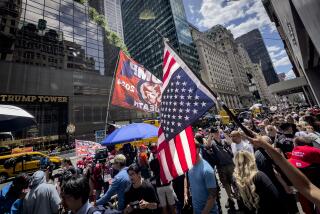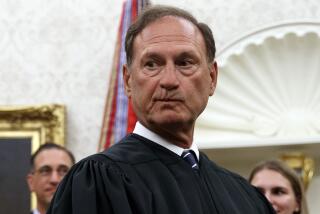Editorial: The Supreme Court shouldn’t bless a giant cross on public property
- Share via
The Supreme Court on Wednesday heard arguments about whether the 1st Amendment’s ban on the “establishment” of religion by government is violated by a 40-foot cross that sits on public land on a traffic island in Bladensburg, Md., near Washington, D.C.
The answer to that question is an emphatic yes, for the reason offered by a federal appeals court. It held that the so-called Peace Cross, erected in the 1920s as a memorial to the fallen in World War I, sends the message to a “reasonable observer” that the government agency that maintains the cross “either places Christianity above other faiths, views being American and Christian as one [and] the same, or both.”
The Supreme Court should affirm that ruling.
The justices long have struggled with when to allow religious symbols on public property. In a pair of decisions in 2005, the justices ruled against the posting of the Ten Commandments in Kentucky courthouses while upholding the placement of a Ten Commandments monument on the grounds of the Texas state capitol. Both decisions were 5-4, and only one justice — Stephen Breyer — was in the majority in both.
Enter the Fray: First takes on the news of the minute »
Breyer voted to uphold the Ten Commandments monument in Texas partly because it had stood for 40 years without being challenged in court. He also worried that a court ruling dismantling the monument would create the sort of religious divisiveness the 1st Amendment was designed to avoid. At Wednesday’s argument, he suggested that the Peace Cross might also be justified by its longevity. “History counts,” he said.
A decision to “grandfather in” the Peace Cross just because it’s been around for a long time would be disappointing. Even worse would be a ruling that used this case to loosen standards for judging all religious displays on public property. That’s essentially what a lawyer for the American Legion asked the court to do, suggesting to the court that such displays are unconstitutional only if they “coerce” onlookers to participate in a religious observance. The right question for the court is whether a religious symbol on public property endorses one religion over others. The Peace Cross clearly does.
In defending the cross, a lawyer for the Maryland-National Capital Park and Planning Commission pointed out that there is a long tradition of crosses being used to memorialize war dead. But Justice Elena Kagan noted that, while a cross might seem to Christians the natural way to honor the fallen, “for members of other faiths, that symbol is not a way to memorialize the dead and does not have that meaning.”
At a time when Americans subscribe to a wide variety of religious beliefs — or none at all — it’s vital for government to be religiously neutral. This imposing cross may serve as a commemoration of the dead, but it does so as the central symbol of the Christian religion. It shouldn’t be located on public property.
Follow the Opinion section on Twitter @latimesopinionand Facebook
More to Read
A cure for the common opinion
Get thought-provoking perspectives with our weekly newsletter.
You may occasionally receive promotional content from the Los Angeles Times.










